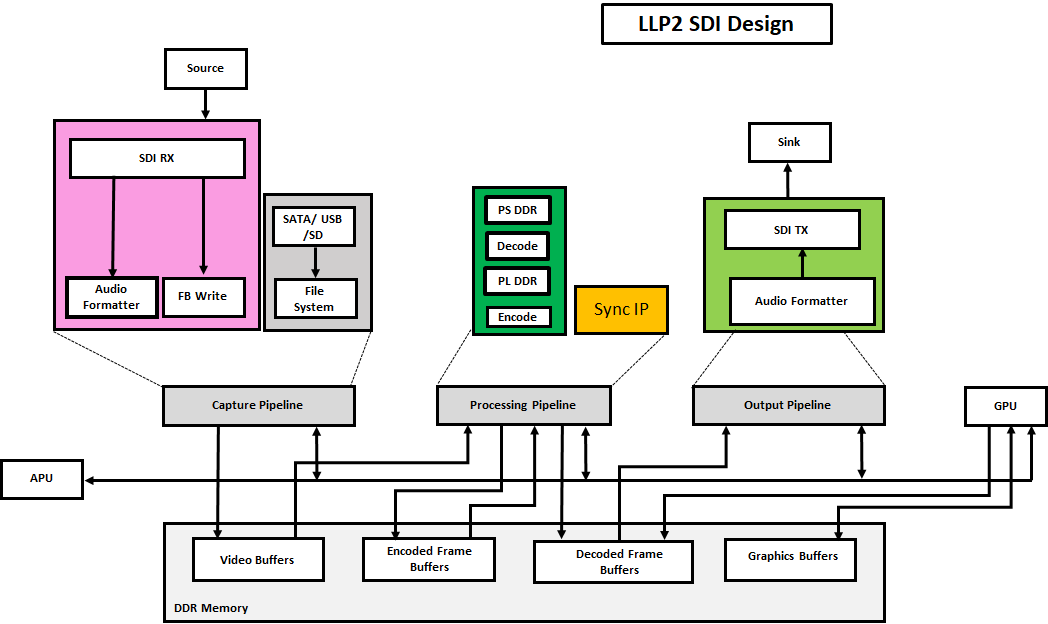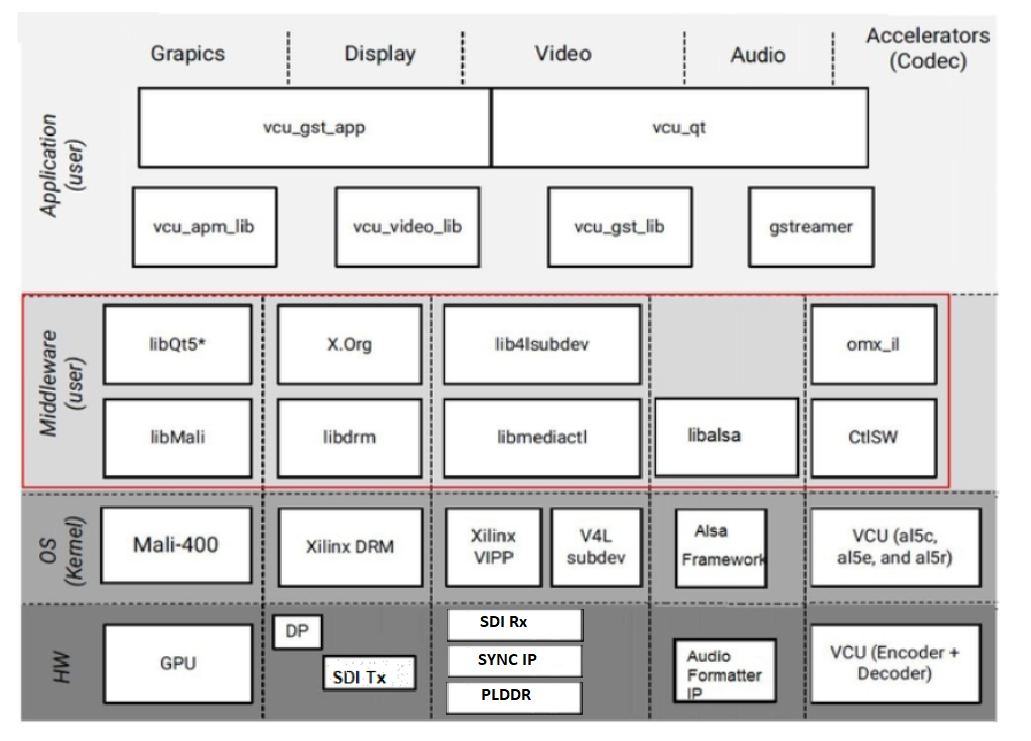...
| Table of Contents | ||
|---|---|---|
|
1 Overview
This module enables the capture of video from an SDI Rx subsystem implemented in the PL. The video can be displayed through the SDI Tx subsystem implemented in the PL. The module can stream-out and stream-in live captured video frames through an Ethernet interface at ultra-low latencies using Sync IP. This module supports multi-stream for XV20 pixel format. In this design, PL_DDR is used for decoding and PS_DDR for encoding so that DDR bandwidth would be enough to support high bandwidth VCU applications requiring simultaneous encoder and decoder operations and transcoding at 4k @60 FPS.
The VCU encoder and decoder operate in slice mode. An input frame is divided into multiple slices (8 or 16) horizontally. The encoder generates a slice_done interrupt at every end of the slice. Generated NAL unit data can be passed to a downstream element immediately without waiting for the frame_done interrupt. The VCU decoder also starts processing data as soon as one slice of data is ready in its circular buffer instead of waiting for complete frame data. The Sync IP does an AXI transaction-level tracking so that the producer and consumer can be synchronized at the granularity of AXI transactions instead of granularity at the video buffer level. Sync IP is responsible for synchronizing buffers between Capture DMA and VCU encoder as both works on the same buffer.
The capture element (FB write DMA) writes video buffers in raster-scan order. SyncIP monitors the buffer level while the capture element is writing into DRAM and allows the encoder to read input buffer data if the requested data is already written by DMA, otherwise it blocks the encoder until DMA completes its writes. On the decoder side, the VCU decoder writes decoded video buffer data into DRAM in block-raster scan order and displays reads data in raster-scan order. To avoid display under-run problems, the software ensures a phase difference of "~frame_period/2", so that decoder is ahead compared to display.
This design supports the following video interfaces:
Sources:
- SDI-Rx capture pipeline implemented in the PL.
- Stream-In from network or internet.
Sinks:
- SDI-Tx display pipeline implemented in the PL.
VCU Codec:
- Video Encode/Decode capability using VCU hard block in PL.
- AVC/HEVC encoding
- Encoder/decoder parameter configuration.
Video format:
- XV20
Supported Resolution:
The table below provides the supported resolution from command line app only in this design.
| Resolution | Command Line | |
| Single Stream | Multi-stream | |
| 4kp60 | √ | NA |
| 4kp30 | √ | NA |
| 1080p60 | √ | NA |
√ - Supported
NA – Not applicable
x – Not supported
The below table gives information about the features supported in this design.
| Pipeline | Input source | Format | Output Type | Resolution | VCU codec |
|---|---|---|---|---|---|
Capture--> Encode--> Decode--> Display | SDI-Rx | XV20 | SDI-Tx | 4kp60/4kp30/1080p60 | HEVC/AVC |
Stream-Out pipeline | SDI-Rx | XV20 | Stream-Out | 4kp60/4kp30/1080p60 | HEVC/AVC |
Stream-in pipeline | Stream-In | XV20 | SDI-Tx | 4kp60/4kp30/1080p60 | HEVC/AVC |
The below figure shows the PL DDR SDI design hardware block diagram.
The below figure shows the PL DDR SDI design software block diagram.
1.1 Board Setup
Refer below link for Board Setup
1.2 Run Flow
The TRD package is released with the source code, Vivado project, Petalinux BSP, and SD card image that enables the user to run the demonstration. It also includes the binaries necessary to configure and boot the ZCU106 board. Prior to running the steps mentioned in this wiki page, download the TRD package and extract its contents to a directory referred to as ‘TRD_HOME' which is the home directory.
Refer below link to download all TRD contents.
TRD package contents are placed in the following directory structure. The user needs to copy all the files from the $TRD_HOME/images/vcu_llp2_sdi_xv20 to FAT32 formatted SD card directory.
| Code Block | ||
|---|---|---|
| ||
rdf0428-zcu106-vcu-trd-2019-2 ├── apu │ └── vcu_petalinux_bsp │ └── xilinx-vcu-zcu106-v2019.2-final.bsp ├── images │ ├── vcu_llp2_sdi_xv20 │ │ ├── autostart.sh │ │ ├── bin │ │ ├── BOOT.BIN │ │ ├── config │ │ ├── image.ub │ │ ├── system.dtb │ │ └── vcu ├── pl │ ├── constrs │ │ ├── hdmi_plddr.xdc │ │ ├── misc.xdc │ │ ├── sdi_interclk.xdc │ │ ├── vcu_10g.xdc │ │ ├── vcu_audio_async.xdc │ │ ├── vcu_audio_w10.xdc │ │ ├── vcu_audio.xdc │ │ ├── vcu_hdmirx.xdc │ │ ├── vcu_hdmitx.xdc │ │ ├── vcu_pcie.xdc │ │ ├── vcu_sdirx_place.xdc │ │ ├── vcu_sdirx_timing.xdc │ │ ├── vcu_sdirxtx_place.xdc │ │ ├── vcu_sdirxtx_plddr_place.xdc │ │ ├── vcu_sdirxtx_plddr_timing.xdc │ │ ├── vcu_sdirxtx_timing.xdc │ │ ├── vcu_sditx_async.xdc │ │ ├── vcu_sditx_place.xdc │ │ ├── vcu_sditx_timing.xdc │ │ ├── vcu_trd_async.xdc │ │ ├── vcu_trd.xdc │ │ ├── vcu_uc2_async.xdc │ │ └── vcu_uc2.xdc │ ├── designs │ │ ├── zcu106_llp2_sdi │ ├── prebuild │ │ ├── zcu106_llp2_sdi │ └── srcs │ ├── hdl │ └── ip └── README.txt |
...
| Code Block | ||
|---|---|---|
| ||
config/
├── 1080p60
│ ├── Display
│ │ ├── Single_1080p60_AVC_25Mbps.cfg
│ │ └── Single_1080p60_HEVC_25Mbps.cfg
│ ├── Stream-in
│ │ ├── Single_1080p60_AVC_25Mbps.sh
│ │ └── Single_1080p60_HEVC_25Mbps.sh
│ └── Stream-out
│ ├── Single_1080p60_AVC_25Mbps.cfg
│ ├── Single_1080p60_AVC_25Mbps.sh
│ ├── Single_1080p60_HEVC_25Mbps.cfg
│ └── Single_1080p60_HEVC_25Mbps.sh
├── 4kp30
│ ├── Display
│ │ ├── Single_4kp30_AVC_25Mbps.cfg
│ │ └── Single_4kp30_HEVC_25Mbps.cfg
│ ├── Stream-in
│ │ ├── Single_4kp30_AVC_25Mbps.sh
│ │ └── Single_4kp30_HEVC_25Mbps.sh
│ └── Stream-out
│ ├── Single_4kp30_AVC_25Mbps.cfg
│ ├── Single_4kp30_AVC_25Mbps.sh
│ ├── Single_4kp30_HEVC_25Mbps.cfg
│ └── Single_4kp30_HEVC_25Mbps.sh
└── 4kp60
├── Display
│ ├── Single_4kp60_AVC_25Mbps.cfg
│ └── Single_4kp60_HEVC_25Mbps.cfg
├── Stream-in
│ ├── Single_4kp60_AVC_25Mbps.sh
│ └── Single_4kp60_HEVC_25Mbps.sh
└── Stream-out
├── Single_4kp60_AVC_25Mbps.cfg
├── Single_4kp60_AVC_25Mbps.sh
├── Single_4kp60_HEVC_25Mbps.cfg
└── Single_4kp60_HEVC_25Mbps.sh |
1.2.1 GStreamer Application (vcu_gst_app)
The vcu_gst_app is a command-line multi-threaded Linux application. The command-line application requires an input configuration file (.cfg) to be provided in the plain text.
...
Refer below link for detailed run flow steps
1.3 Build Flow
Refer below link for detailed build flow steps
...
2 Other Information
2.1 Known Issues
- For VCU related known issues please refer AR# 72293: PetaLinux 2019.1 - Product Update Release Notes and Known Issues.
- Design has a negative slack of WNS around -50 ps . However it does not affect the functionality of the design in the long run also and will be fixed in next release.
2.2 Limitations
- For VCU related limitations please refer AR# 72293: PetaLinux 2019.1 - Product Update Release Notes and Known Issues and PG252 link.
2.3 Optimum VCU Encoder parameters for use-cases
Video streaming:
- Video streaming use-case requires very stable bitrate graph for all pictures.
- It is good to avoid periodic large Intra pictures during the encoding session
- Low-latency rate control (hardware RC) is the preferred control-rate for video streaming, it tries to maintain equal amount frame sizes for all pictures.
- Good to avoid periodic Intra frames instead use low-delay-p (IPPPPP…)
- VBR is not a preferred mode of streaming.
...
- Enable profile=high and use qp-mode=auto for low-bitrate encoding use-cases.
- The high profile enables 8x8 transform which results in better video quality at low bitrates.
...
3 Appendix A - Input Configuration File (input.cfg)
The example configuration files are stored at /media/card/config/ folder.
Common Configuration:
It is the starting point of common configuration.
Num of Input:
1
...
GoP Length:
The distance between two consecutive I frames
Options: 1-1000
Preset:
Options: Custom
Exit
It indicates to the application that the configuration is over.
Streaming Configuration:
It is the starting point of streaming configuration.
Streaming Num:
Starting Nth Streaming configuration.
Options: 1
Host IP:
The host to send the packets to
Options: 192.168.25.89 or Windows PC IP
Port:
The port to send the packets to
Options: 5004, 5008, 5012 and 5016
Exit
It indicates to the application that the configuration is over.
Trace Configuration:
It is the starting point of trace configuration.
FPS Info:
To display fps info on the console.
Options: True, False
APM Info:
To display APM counter number on the console.
Options: True, False
Pipeline Info:
To display pipeline info on console.
Options: True, False
Exit
It indicates to the application that the configuration is over.
...
4 Appendix B
- SDI source can be locked to any resolution. Run the below command for all media nodes to print media device topology where "mediaX" represents different media nodes. In the topology, log look for the “v_smpte_uhdsdi_rx_ss” string to identify the SDI input source media node.
...

